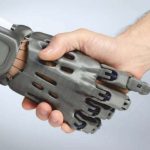Researchers at the University of Houston and colleagues have developed a flexible epicardial patch which can monitor heart function and even administer treatments, such as thermal ablation and heart pacing. The device can harvest power directly from the movement of the beating heart and its flexibility means that it conforms well with the epicardial surface, allowing it to monitor the heart at various locations simultaneously.
At present, implantable devices that are used to monitor and treat the heart, such as pacemakers, largely consist of rigid components, meaning that they do not blend well with moving heart muscle. Soft alternatives have been developed, but to date they haven’t been sophisticated enough to collect numerous types of cardiac data.
This latest development aims to change this. “The device marks the first time bioelectronics have been developed based on fully rubbery electronic materials that are compatible with heart tissue, allowing the device to solve the limitations of previous cardiac implants, which are mainly made out of rigid electronic materials,” said Cunjiang Yu, a researcher involved in the study.
Since the device is flexible, it is less likely to damage the heart muscle as it beats, and it can make close contact with the epicardial surface over a wide area, allowing for more accurate and comprehensive data collection. The patch can collect a wide variety of medically relevant data, including electrophysiological activity, temperature, and strain.
Strikingly, it can also make therapeutic interventions in the form of thermal ablation and heart pacing, and can harvest energy from the movement of the heart, potentially meaning it may not need an external power source.
“Unlike bioelectronics primarily based on rigid materials with mechanical structures that are stretchable on the macroscopic level, constructing bioelectronics out of materials with moduli matching those of the biological tissues suggests a promising route towards next-generational bioelectronics and biosensors that do not have a hard-soft interface for the heart and other organs,” said Yu. “Our rubbery epicardial patch is capable of multiplexed ECG mapping, strain and temperature sensing, electrical pacing, thermal ablation and energy harvesting functions.














